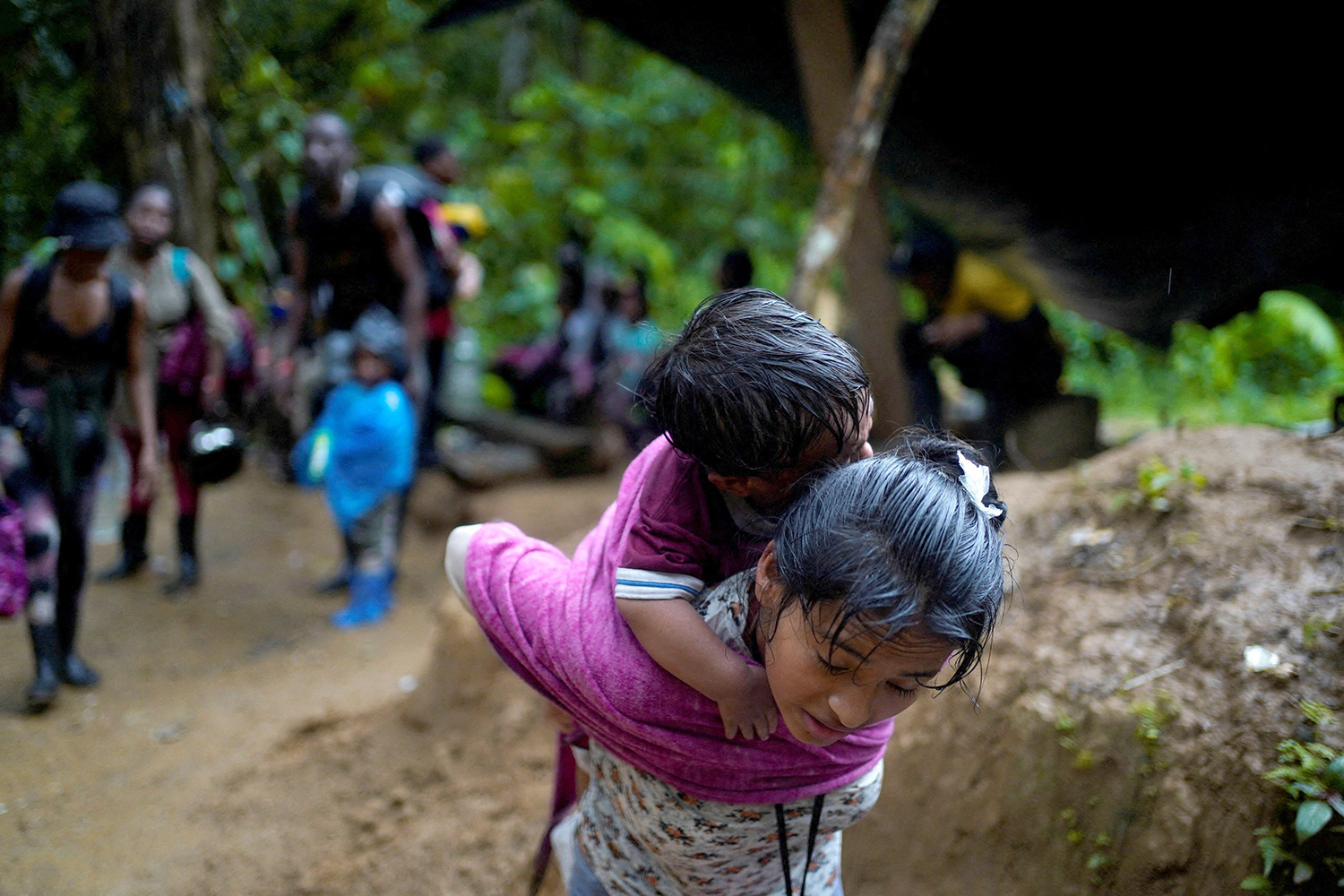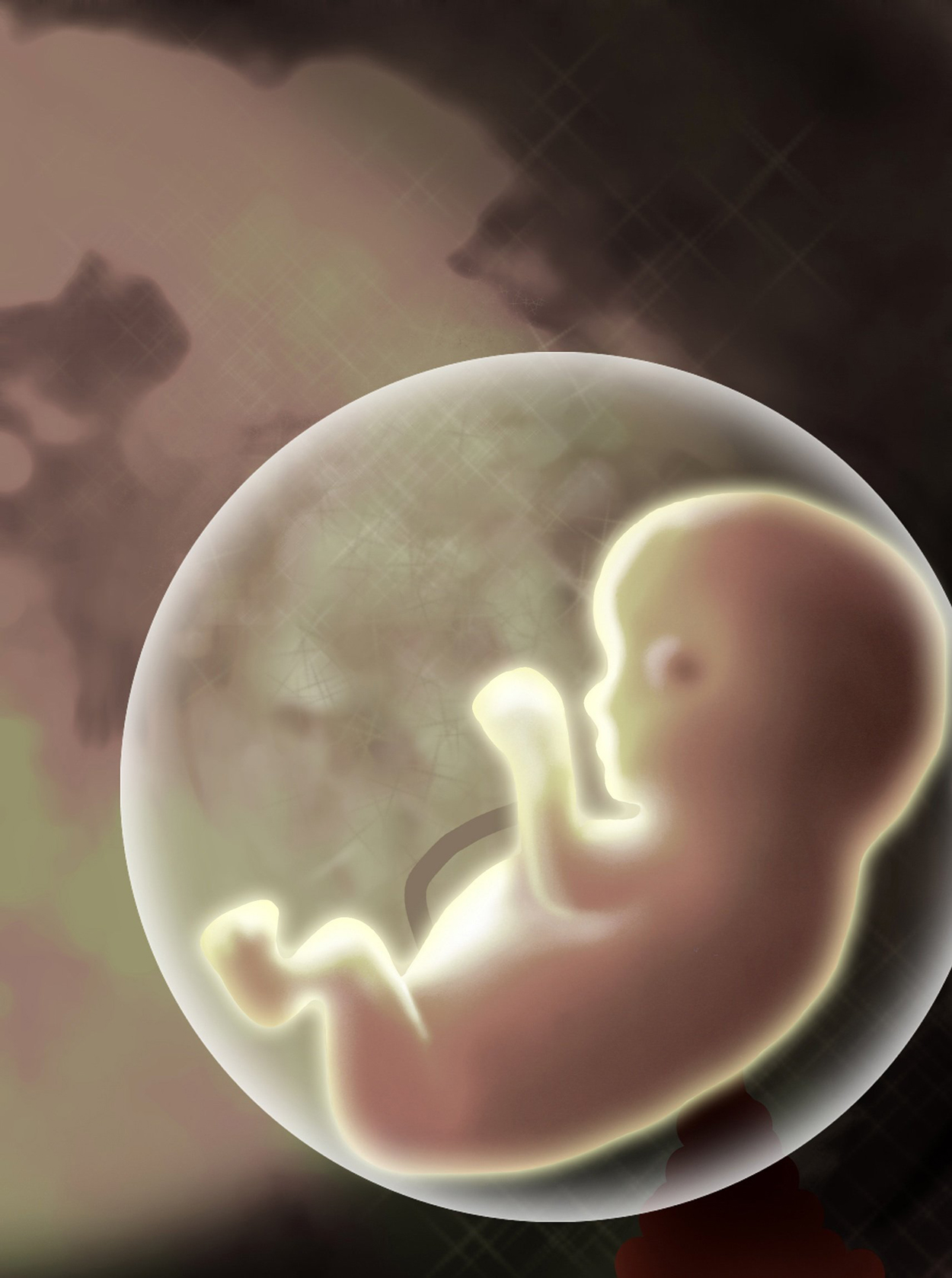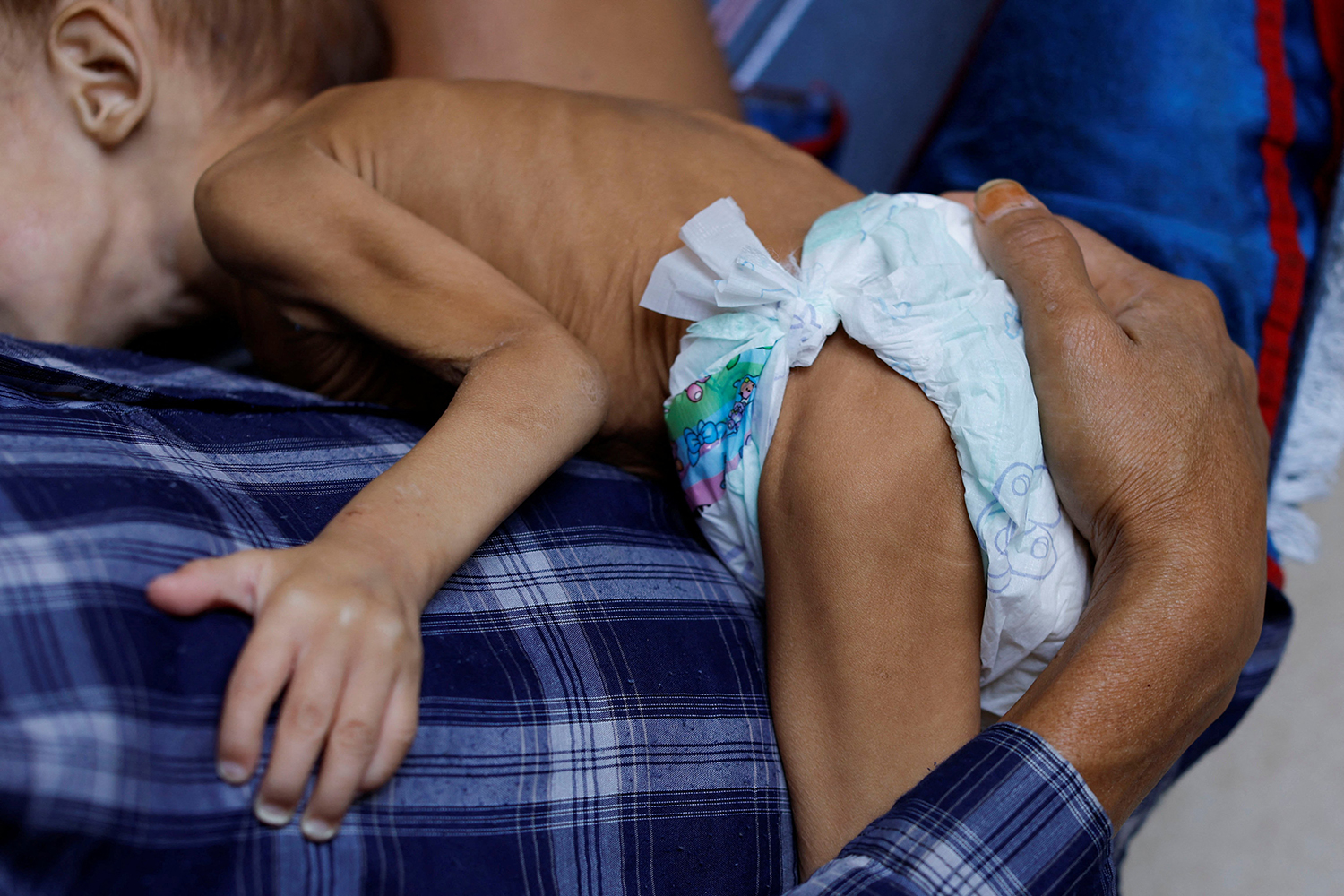Innocence under Siege
December 14, 2023 at 10:30 a.m.

From every direction it seems, children face danger to life and liberty and bear the highest consequences for global problems. This compilation illustrates where children are often the most vulnerable.
Migrants & Refugees
Immigration authorities encountered more than 152,000 unaccompanied minors at or near the U.S.-Mexico border in fiscal year 2022, an all-time high.

A young female carries a child on her back toward the Darién Gap in Acandi, Colombia, July 9, 2023. OSV News photo/Adri Salido, Reuters
During displacement, refugee children face traumatic events or hardships: living in refugee camps, separation from family, loss of community, uncertainty about the future, harassment and long-distance travel on foot.
Migrant children have also left families behind, fleeing domestic abuse, poverty, criminal gangs or corruption. Some migrant parents send their children across the border alone to avail themselves of asylum protections for unaccompanied minors.
Children may be pushed to rely on smugglers to seek safety or opportunities, or to reunite with family members abroad; under these circumstances, a smuggler may turn out to be a trafficker who ends the journey in exploitation. According to the 2022 World Migration Report, 45% of all identified victims of trafficking had been trafficked across international borders.
Sources: National Child Trauma Stress Network, International Organization
for Migration, AntiSlavery.org, Council on Foreign Relations
Abortion
More than 64 million children have been killed by abortion since the Supreme Court’s 1973 Roe v. Wade decision.
 An illustration depicts a human fetus in a womb. CNS illustration/Emily Thompson
An illustration depicts a human fetus in a womb. CNS illustration/Emily ThompsonAbortions increased by 5% between 2020-2021.
New Jersey does not report its abortion numbers; neither do California, Maryland and New Hampshire. The highest reported in 2021 were Florida – 79,817, and New York – 63,487.
SCOTUS’s Dobbs v. Jackson overturned Roe in June 2022, but abortions continue at a steady pace under state constitutions.
Abortion was enshrined in state law in January 2022 by the New Jersey legislature and Gov. Phil Murphy.
A June Gallop poll found that record-high numbers were in favor of abortion in later stages of pregnancy; 37% of respondents supported second-trimester abortions and 22% supported third trimester abortions.
Sources: National Right to Life, Gallup, ABC News, Centers for Disease Control, KFF.com, NJ.gov
Climate Instability
Children’s bodies are developing physically, which can make them more vulnerable to climate-related hazards like heat and poor air quality. Children are developing emotionally, as their brains continue to grow throughout adolescence.
 A child under care for malnutrition in Santo Antonio Children’s Hospital, Boa Vista, Brazil. OSV News/Amanda Perobelli, Reuters
A child under care for malnutrition in Santo Antonio Children’s Hospital, Boa Vista, Brazil. OSV News/Amanda Perobelli, ReutersRising temperatures and decreased air quality affect kids by increasing asthma attacks and allergies, worsening pregnancy outcomes, creating food insecurity, increasing mental health problems and developmental delays.
At 2°C and 4°C of global warming:
Childhood asthma incidence is projected to increase between 4% and 11%, respectively, due to changes in air quality.
Childhood cases of Lyme disease are projected to increase 79% to 241% – an additional 2,600 to 23,400 new cases per year.
Flooding is projected to cause 1-2 million+ children to temporarily be displaced or lose their homes.
Sources: EPA, Harvard School of Public Health
Child Labor & Trafficking
About 160 million children around the world are engaged in child labor: nearly half of them – 79 million children – work in hazardous conditions. Although concentrated in the world’s poorest countries (86.6 million in sub-Saharan Africa), labor trafficking affects every country in the world.
 A file photo shows a mural depicting child labor. OSV News photo/Shanshan Chen, Reuters
A file photo shows a mural depicting child labor. OSV News photo/Shanshan Chen, ReutersPoverty is the main driver behind child labor.
Nearly 70% of child laborers work in agriculture; others work in factories, domestic service or forced labor via military service or child trafficking.
Most hazardous forms of labor include slavery, prostitution, pornography, drug production or trafficking, debt bondage and other work that can cause injury or moral corruption. 22,000 children are killed at work each year in hazardous conditions.
27% of trafficking victims are children. ILO reports that forced labor generated $150 billion in illegal profits per year; $51.8 billion in forced labor profits come from the Asia-Pacific region.
66% of child trafficking victims are girls. Forced to drop out of school to work can trap them in a cycle of extreme poverty and increased vulnerability. 99% of victims trafficked for sexual exploitation are women and girls.
Traffickers use tricks to find their victims. Often, they will come to a village claiming to be recruiters for a large business, promising job training. Another ruse is a young man offering to accept a village girl with no dowry, a temptation for impoverished families.
Sources: International Labor Organization, WorldsChildren.org, WorldVision.org
War & Conflict
One in six children around the world – more than 449 million children – are living in a conflict zone.
Holy Land: Since the October 7 attack on Israel by Hamas, 33 children were killed in Israel, an estimated 40 Israeli children were taken hostage, and an estimated 5,500 children were killed in Gaza.
 A child from Ukraine waits for a bus going to the Netherlands in Beregsurany, Hungary, March 1, 2022, after fleeing Russia’s invasion of Ukraine. CNS photo/Bernadett Szabo, Reuters
A child from Ukraine waits for a bus going to the Netherlands in Beregsurany, Hungary, March 1, 2022, after fleeing Russia’s invasion of Ukraine. CNS photo/Bernadett Szabo, ReutersUkraine: More than 540 Ukrainian children have been killed and over 1,000 injured since Russia invaded Ukraine in February 2022. A massive number of children have been kidnapped and taken back to Russia; numbers are not known, but estimates by government authorities are approximately 300,000 – though Russia claims it has taken 700,000 for reindoctrinating.
Yemen: During the 2014-2023 civil war, more than 11,000 children have been killed or injured.
Syria: Between 2011-2023, Syrian regime forces and Iranian militias have killed more than 20,000 children; Russian forces have killed an additional 2,048 children.
Loss and disruption can lead to high rates of depression and anxiety in war-affected children. The importance of family, its nurture and support, means that being separated from parents can be one of the most significant war ordeals of all, particularly for younger children.
Attacks on schools and civilians leave children in constant fear, suffering from profound negative emotions. This constant state of anxiety can lead to bed wetting, difficulty falling asleep, nightmares, and strained relationships with their loved ones.
Children that have grown up surrounded by armed conflict may show aggression and withdrawal in their behavior with peers and family members. They may start fighting with or bullying other children.
Sources: United Nations High Commissioner for Human Rights, SavetheChildren.net, news.un.org, statista.com
Related Stories
Sunday, December 14, 2025
E-Editions
Events
From every direction it seems, children face danger to life and liberty and bear the highest consequences for global problems. This compilation illustrates where children are often the most vulnerable.
Migrants & Refugees
Immigration authorities encountered more than 152,000 unaccompanied minors at or near the U.S.-Mexico border in fiscal year 2022, an all-time high.

A young female carries a child on her back toward the Darién Gap in Acandi, Colombia, July 9, 2023. OSV News photo/Adri Salido, Reuters
During displacement, refugee children face traumatic events or hardships: living in refugee camps, separation from family, loss of community, uncertainty about the future, harassment and long-distance travel on foot.
Migrant children have also left families behind, fleeing domestic abuse, poverty, criminal gangs or corruption. Some migrant parents send their children across the border alone to avail themselves of asylum protections for unaccompanied minors.
Children may be pushed to rely on smugglers to seek safety or opportunities, or to reunite with family members abroad; under these circumstances, a smuggler may turn out to be a trafficker who ends the journey in exploitation. According to the 2022 World Migration Report, 45% of all identified victims of trafficking had been trafficked across international borders.
Sources: National Child Trauma Stress Network, International Organization
for Migration, AntiSlavery.org, Council on Foreign Relations
Abortion
More than 64 million children have been killed by abortion since the Supreme Court’s 1973 Roe v. Wade decision.
 An illustration depicts a human fetus in a womb. CNS illustration/Emily Thompson
An illustration depicts a human fetus in a womb. CNS illustration/Emily ThompsonAbortions increased by 5% between 2020-2021.
New Jersey does not report its abortion numbers; neither do California, Maryland and New Hampshire. The highest reported in 2021 were Florida – 79,817, and New York – 63,487.
SCOTUS’s Dobbs v. Jackson overturned Roe in June 2022, but abortions continue at a steady pace under state constitutions.
Abortion was enshrined in state law in January 2022 by the New Jersey legislature and Gov. Phil Murphy.
A June Gallop poll found that record-high numbers were in favor of abortion in later stages of pregnancy; 37% of respondents supported second-trimester abortions and 22% supported third trimester abortions.
Sources: National Right to Life, Gallup, ABC News, Centers for Disease Control, KFF.com, NJ.gov
Climate Instability
Children’s bodies are developing physically, which can make them more vulnerable to climate-related hazards like heat and poor air quality. Children are developing emotionally, as their brains continue to grow throughout adolescence.
 A child under care for malnutrition in Santo Antonio Children’s Hospital, Boa Vista, Brazil. OSV News/Amanda Perobelli, Reuters
A child under care for malnutrition in Santo Antonio Children’s Hospital, Boa Vista, Brazil. OSV News/Amanda Perobelli, ReutersRising temperatures and decreased air quality affect kids by increasing asthma attacks and allergies, worsening pregnancy outcomes, creating food insecurity, increasing mental health problems and developmental delays.
At 2°C and 4°C of global warming:
Childhood asthma incidence is projected to increase between 4% and 11%, respectively, due to changes in air quality.
Childhood cases of Lyme disease are projected to increase 79% to 241% – an additional 2,600 to 23,400 new cases per year.
Flooding is projected to cause 1-2 million+ children to temporarily be displaced or lose their homes.
Sources: EPA, Harvard School of Public Health
Child Labor & Trafficking
About 160 million children around the world are engaged in child labor: nearly half of them – 79 million children – work in hazardous conditions. Although concentrated in the world’s poorest countries (86.6 million in sub-Saharan Africa), labor trafficking affects every country in the world.
 A file photo shows a mural depicting child labor. OSV News photo/Shanshan Chen, Reuters
A file photo shows a mural depicting child labor. OSV News photo/Shanshan Chen, ReutersPoverty is the main driver behind child labor.
Nearly 70% of child laborers work in agriculture; others work in factories, domestic service or forced labor via military service or child trafficking.
Most hazardous forms of labor include slavery, prostitution, pornography, drug production or trafficking, debt bondage and other work that can cause injury or moral corruption. 22,000 children are killed at work each year in hazardous conditions.
27% of trafficking victims are children. ILO reports that forced labor generated $150 billion in illegal profits per year; $51.8 billion in forced labor profits come from the Asia-Pacific region.
66% of child trafficking victims are girls. Forced to drop out of school to work can trap them in a cycle of extreme poverty and increased vulnerability. 99% of victims trafficked for sexual exploitation are women and girls.
Traffickers use tricks to find their victims. Often, they will come to a village claiming to be recruiters for a large business, promising job training. Another ruse is a young man offering to accept a village girl with no dowry, a temptation for impoverished families.
Sources: International Labor Organization, WorldsChildren.org, WorldVision.org
War & Conflict
One in six children around the world – more than 449 million children – are living in a conflict zone.
Holy Land: Since the October 7 attack on Israel by Hamas, 33 children were killed in Israel, an estimated 40 Israeli children were taken hostage, and an estimated 5,500 children were killed in Gaza.
 A child from Ukraine waits for a bus going to the Netherlands in Beregsurany, Hungary, March 1, 2022, after fleeing Russia’s invasion of Ukraine. CNS photo/Bernadett Szabo, Reuters
A child from Ukraine waits for a bus going to the Netherlands in Beregsurany, Hungary, March 1, 2022, after fleeing Russia’s invasion of Ukraine. CNS photo/Bernadett Szabo, ReutersUkraine: More than 540 Ukrainian children have been killed and over 1,000 injured since Russia invaded Ukraine in February 2022. A massive number of children have been kidnapped and taken back to Russia; numbers are not known, but estimates by government authorities are approximately 300,000 – though Russia claims it has taken 700,000 for reindoctrinating.
Yemen: During the 2014-2023 civil war, more than 11,000 children have been killed or injured.
Syria: Between 2011-2023, Syrian regime forces and Iranian militias have killed more than 20,000 children; Russian forces have killed an additional 2,048 children.
Loss and disruption can lead to high rates of depression and anxiety in war-affected children. The importance of family, its nurture and support, means that being separated from parents can be one of the most significant war ordeals of all, particularly for younger children.
Attacks on schools and civilians leave children in constant fear, suffering from profound negative emotions. This constant state of anxiety can lead to bed wetting, difficulty falling asleep, nightmares, and strained relationships with their loved ones.
Children that have grown up surrounded by armed conflict may show aggression and withdrawal in their behavior with peers and family members. They may start fighting with or bullying other children.
Sources: United Nations High Commissioner for Human Rights, SavetheChildren.net, news.un.org, statista.com










